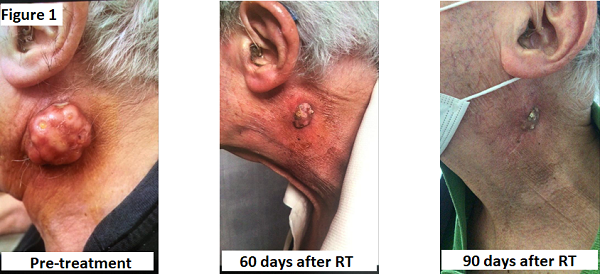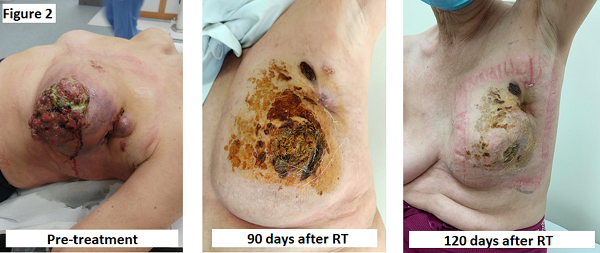HIGH RADIATION DOSE DELIVERY BY LATTICE-RT TO HYPOXIC AREAS IN BULKY TUMOURS: A MULTICENTRIC STUDY.
PO-1462
Abstract
HIGH RADIATION DOSE DELIVERY BY LATTICE-RT TO HYPOXIC AREAS IN BULKY TUMOURS: A MULTICENTRIC STUDY.
Authors: Silvana Parisi1, Gianluca Ferini2, Antonio Pontoriero1, Anna Viola3, Alberto Cacciola1, Sara Lillo1, Giacomo Ferrantelli1, Consuelo Tamburella1, Gabriele Lo Giudice1, Vito Valenti2, Antonella Tripoli2, Federico Chillari1, Stefano Pergolizzi1
1G. Martino Messina University Hospital, Department of Biomedical, Dental and Morphological and Functional Imaging Sciences, Messina, Italy; 2REM Radiotherapy srl, Radiotherapy and Clinical Oncology, Viagrande, Italy; 3IOM Foundation, Radiotherapy and Clinical Oncology, Viagrande, Italy
Show Affiliations
Hide Affiliations
Purpose or Objective
To evaluate feasibility,
toxicities and clinical response in Stage IV patients with bulky tumour treated
with LATTICE technique. The aim of the present study, called LATTICE_01, is to deliver high doses of radiation to hypoxic
areas within the gross tumour volumes (GTV). The goals of this innovative
approach are to stimulate abscopal effect and to activate bystander effect on
the nearby normoxic areas.
Material and Methods
From June 2020 to October 2021 we selected all metastatic patients with bulky
tumour both unresectable and unsuitable to ablative radiotherapy in the experimental
centers (G. Martino Messina University Hospital, REM
Radiotherapy srl Viagrande, IOM Viagrande Foundation). Among these, we enrolled the patients who had a Karnofsky Performance
Status (KPS) ≥ 60, a life expectancy major of six months and permissive
clinical/biochemical parameters.
Results
Twenty-two patients (17 male
and 5 female) with histological diagnosis of neoplastic and systemic disease
were enrolled. The median
age was 75 years (range 42-91); all patients had contrast-enhanced CT,
18F-PET/CT and in selected cases contrast-enhanced MRI.
The
first therapy’s phase provided to deliver high radiation doses within bulky
tumour using “balls of dose”, called VERTEX, positioned between hypoxic and
normoxic tissue following a non-geometric model. The median total dose
delivered on VERTEX was 15Gy (range 10-27Gy) in 1-5 fractions. In the second treatment
phase, a median total dose of 30Gy (range 18 – 40,05Gy) was delivered on GTV ±
Clinical Target Volume (CTV).
With a median follow up of seven months (range 1-13 months) we recorded an 89% of clinical response (figure 1; 2). Particularly, 23% of the patients showed a complete response (CR) and in 63% of patients, a partial response (PR) has been observed. Stable disease (SD) and progression disease (PD) were 9% and 4.5% respectively. The toxicities records were poor: radiodermatitis G1 have been observed in the 36% of the patients, while no grade 3 toxicities were recorded.


Conclusion
The LATTICE_01 approach is feasible and well
tolerated with encouraging results in terms of toxicities and overall response
rate. These preliminary results seem to indicate that this kind of therapy
could emerge as a therapeutic option in this setting of patients.